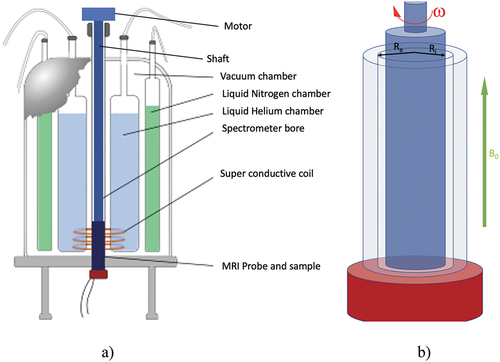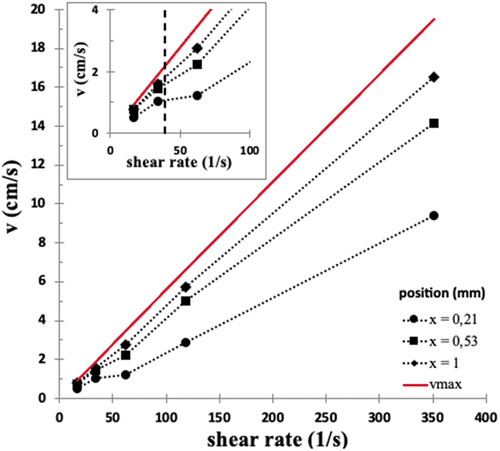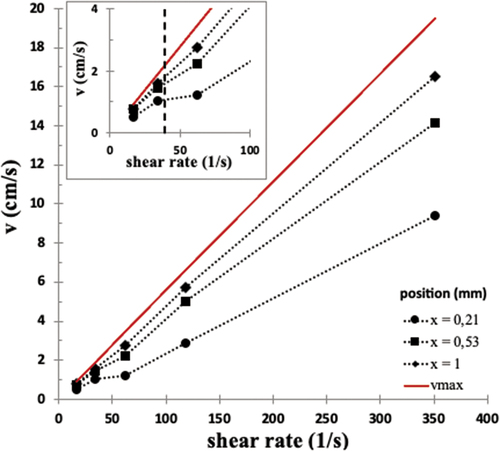ABSTRACT
NMR spectroscopy was used to characterise the velocity profile in nematic solutions of poly(γ-benzyl-L-glutamate) (PBLG) in m-cresol during the application of a simple shear-flow at constant shear-rate values. In this study, the rheo-NMR technique was used that allows an insight over the fluid dynamics during the application of a shear flow in the presence of an external magnetic field, in a perpendicular direction to the shear gradient. Using this Magnetic Resonance Imaging (MRI) based technique, the velocity profile developed inside the system is accessed.
KEYWORDS:
Introduction
The application of Magnetic Resonance Imaging (MRI) to determine material properties, such as flow and molecular orientation, was proposed by Callaghan [Citation1]. The name rheo-NMR was attributed to the combination of rheological and NMR techniques. The results obtained from rheo-NMR provide valuable insights into the molecular dynamics and mechanical behaviour of viscoelastic materials that are sensitive to an external magnetic field, which can be used for the development of new materials or to improve the properties of existing ones [Citation2,Citation3]. Several studies, applied to very different systems, were conducted using this technique, such as the ultrafast MRI study to visualise steady and unsteady Taylor–Couette flows applied to water [Citation4].
The PBLG is known to be a rigid molecule and to form lyotropic mesophases in solutions above a certain critical concentration in m-cresol, which is polymer molecular weight dependent, at a certain temperature. In the liquid crystalline regime, at intermediate and high shear rates, these solutions generally present a shear-aligning behaviour.
The lyotropic liquid crystalline polymeric system poly(γ-benzyl-l-glutamate) in m-cresol (PBLG/m-cresol) has been intensively studied by rheology [Citation5–7]. Rheo-NMR techniques have also been considered to further characterise PBLG/m-cresol system and contributed to the knowledge of its fluid dynamics and physical properties [Citation8–10].
In rheo-NMR, the application of a shear flow refers to the application of a mechanical stress, in the form of shear forces, to the material being studied, using NMR spectroscopy. This mechanical stress causes the molecules in the material to reorient, which can then be studied using NMR techniques, to understand the molecular dynamics and mechanical behaviour of the material. In rheo-NMR experiments, the sample is subjected to a controlled shear flow, and the resulting changes in the NMR signal are measured and analysed.
In rheo-NMR, the studied systems may be assessed by taking into account or focussing in the local or the bulk response of a material. The local response refers to the molecular motion and mechanical behaviour of a material at a specific location, such as near a surface, near a defect, or along a 2D slice of the sample. The bulk response refers to the average molecular motion and mechanical behaviour of the material as a whole, which can be studied using traditional NMR spectroscopy techniques. The bulk response is determined by averaging the local responses over the entire sample. Both the local response and bulk response are important in Rheo-NMR because they provide different information about the molecular fluid dynamics, which allows for the determination of the full viscoelastic parameters of a material.
The results obtained from rheo-NMR on homogeneous and inhomogeneous reorientation, corresponding to the imposition of a sample rotation of α < π/4 and α > π/4, respectively, with respect to the magnetic field direction, allows us to characterise the molecular dynamics [Citation11,Citation12]. The data acquired with this technique can be used to study, for instance, the molecular rotational relaxation time, the local molecular dynamics or the response of the material to mechanical stress [Citation12]. Besides this practical importance, there is a fundamental interest in understanding rheological phenomena, in particular, those of complex fluids [Citation13–15].
In many rheo-NMR experiments, such as velocity profiles determination, a sample is subjected to a controlled shear flow, and the resulting changes in the NMR signal are measured using MRI. The sample is placed in a strong magnetic field, which causes the hydrogen nuclei (protons) in the sample to align with the static magnetic field (B0). Radiofrequency pulses are then applied to the sample, causing the protons to momentarily flip out of alignment to a desired angle with respect to B0. When this momentarily imposed magnetic field is turned off, the protons return to their original alignment, releasing energy that is then detected by the MRI probe. The high sensitivity and spatial resolution of the MRI technique makes it an ideal tool for rheo-NMR experiments, allowing for the study of the molecular dynamics and mechanical behaviour of materials on a microscopic scale along any direction.
In this work, we present further developments in the characterisation of the rheological behaviour of the PBLG/m-cresol system, using the rheo-NMR technique, which allows an insight over the fluid dynamics during the application of a shear flow in the presence of an external magnetic field, in a perpendicular direction to the shear gradient.
Experimental
A solution of PBLG (Mw = 296,100 g/mol, Sigma Chemical) in m-cresol was prepared, with polymer weight fractions of 17 (wt %). Rheological data for solutions with the same weight fractions are available in the literature [Citation5].
The NMR experimental facility was already described in previous studies [Citation8,Citation10]. The velocity 2D-profiles were obtained using rheo-NMR with a Couette geometry, from the flow field mapping in radial slices. The rheo-NMR experiments were performed on a 7,049 T (300 MHz) Bruker Avance III NMR wide bore spectrometer equipped with a superconducting magnet, corresponding to a resonance frequency of 300,130 MHz for 1H, equipped with a special insert for the Bruker Micro 2.5 MRI probe. The fundamental component of the insert is a Couette-flow cell combined to a saddle RF coil for the excitation and detection of the 1H signal, which is outlined in .
Figure 1. (Colour online) Schematic diagram of: (a) the arrangement of magnetic fields used for NMR spectroscopy and microimaging; (b) the Couette cell used inside the standard Bruker micro-imaging gradient system Micro 2.5 for rheo-NMR analysis. The Couette cell consists of two coaxial cylinders having a gap of 1 mm between them, both made of PEEK, being the symmetry axis parallel to the magnetic field direction. The mechanical motion in the device originates from a pulse-programmer-controlled stepper motor placed on the top of the magnet.

The Couette cell consists of a static outer cylinder with an inner diameter of 19 mm and a coaxial rotating cylinder with an outer diameter of 17 mm (1 mm radial gap between them) both made of PEEK. The symmetry axis of the coaxial cylinders is parallel to the direction of the static magnetic field B0. The mechanical motion in the apparatus originates from a pulse-programmer-controlled stepper motor placed on the top of the magnet. The insert is compatible with the standard Bruker temperature regulation. The useful sample height is 20 mm. The measurements were executed for shear rates ranging from 5 to 350 s−1. After loading the sample into the Rheo-NMR system, a pre-shear was imposed to the sample to promote the wetting of the Couette cell walls, thus minimising the slippage near the confining surfaces during the measurements.
The studies were conducted in a standard Bruker micro-imaging gradient system Micro 2.5, capable of generating gradients up to 1,5 T/m along the three axes. 2D velocity profiles were measured with a slice thickness of 1 mm in two dimensions by a standard pulsed gradient spin echo (PGSE) sequence (mic_SEFLOW implemented using Bruker’s software ParaVision 5.1), with Gaussian RF pulse of duration P90 = 1 ms, the velocity-encoding gradient pulses had a duration of δ = 1 ms, and the observation time was Δ = 20 ms. The field of view used has 2,5 × 2,5 cm2 divided by 512 × 512 pixels, and being so, the linear spatial resolution was 48,8 μm. The 2D velocity profiles were acquired using an echo time of TE = 24,4 ms and a repetition time TR = 2 s. Each measurement comprised an accumulation of a total number of scans of NS = 256. All the NMR measurements were performed at 30°C.
Results and discussion
Quantitative flow rate measurements were performed using velocity proton-NMR mapping in the rheo-NMR experiments. The velocity 2D-profiles were obtained, using a Couette geometry, from the flow field mapping in radial slices. These images may reflect the shear-induced texture developed during the applied shear flow.
The MRI images containing the results of the velocity profile in , for the solution of 17% PBLG/m-cresol, are representative for the shear rates of 33,93 and 118,75 s−1. The velocity spectra in a radial direction, obtained for the solution of 17% PBLG/m-cresol, are represented in .
Figure 2. Representative results of the velocity profiles spectra for the 17% PBLG/m-cresol solution: at shear rates: (a) 33,93 and (b) 118,75 s−1, at T = 30°C. Where x = 0 and x = 1 mm correspond respectively to the inner wall of the static outer cylinder and to the outer wall of the rotating inner cylinder positions.

Figure 3. Linear velocity as a function of gap position for the 17% PBLG/m-cresol solution, for several shear rates, at T = 30 ºC. Where x = 0 and x = 1 mm correspond respectively to the inner wall of the static outer cylinder and to the outer wall of the rotating inner cylinder positions.

In it is possible to observe that for lower shear-rate values <62,2 s−1, the velocity profile evolves rather monotonously and attains rapidly a constant value at the position ~0,3 mm. This is reflected by a smooth grey spectrum, see . At higher shear-rate values, the velocity profile reveals a tendency to acquire a linear dependency along the radial position, reflecting a shear-aligning behaviour. This is particularly evident for the shear-rate of 350,6 s−1. Although at this shear-rate the velocity profile shows oscillations that may indicate that flow instabilities may be present.
The velocity in function of the applied shear rate values is represented for different radial positions in and compared with the maximum velocity, vmax, expected to be achieved for each shear rate, and represented by a red line. In the inset, a zoom-in over the low shear rate range, shows the behaviour transition observed in the velocity profile, that occurs at a shear rate of ~40 s−1, identified by the dashed vertical line. Previously, for the same system, this threshold was also identified by rheo-NMR measurements combined with theoretical simulations [Citation8,Citation10], which was now experimentally demonstrated.
Figure 4. (Colour online) Velocity as a function of shear rate for 17% PBLG/m-cresol solution, at T = 30°C, plotted for three different positions along the radial direction at x = 0,21; 0,53 and 1 mm. Inset: zoom-in at low shear rate range, showing the behaviour transition observed in the velocity profile that occurs at a shear rate of ~40 s−1, identified by the dashed vertical line.

Previously [Citation10], the time evolution of the director field distortion of PBLG/m-cresol during the inhomogeneous reorientation following a 90° of the initially homogeneous sample in a strong magnetic field, was observed through a deuterium NMR experiment using benzene-d6 as probe. The numerical simulation of the reorientation process has provided the four Leslie’s viscosities γ1, α1, α2 and hbend, as well as the elastic constants ratio K11/K33. Data from classical rheometry provided the fifth independent Leslie’s viscosity. The full set of viscoelastic parameters was determined for the 17% PBLG/m-cresol using benzene-d6 as probe, as described in the literature [Citation8,Citation10] and presented in .
Table 1. Viscosity coefficients determined for 17% PBLG/m-cresol [Citation10].
In this set of estimated parameters, a negative value was found for the ratio α2/α3, suggesting that PBLG should be considered as a shear tumbling polymer. This assumption finds corroboration in the velocity fluctuations observed for the shear rates between 33,93 s−1 and 118,75 s−1, as shown in . This is a new experimental result crucial for the validation of previous studies performed on this system.
The imposition of a shear-flow in the perpendicular direction to the fixed magnetic field, modifies the director (n – which is the vector field that translates the mean orientation of the polymer liquid crystal molecules) equilibrium state (n//B0), by shifting the n direction towards the shear-flow direction, which leads to the appearance of a more or less complex distribution of the director’s orientation, depending on the applied shear rate.
For shear rates lower than or equal to a critical value, a broad distribution of orientations (corresponding to a lower scalar order parameter) is observed from both the experimental and theoretical point of view, evidencing a non-stationary behaviour of the director [Citation8], where the Frank elasticity dominates. The steady state is only reached for higher shear rates greater than or equal to the critical value, and the director has existence only in the flow plane, i.e. n is perpendicular to B0. For higher shear rate values the shear flow field is dominant and promotes an increase in the orientation of the polymeric chains, which can be transposed to an increase in the scalar order parameter.
The rheo-NMR acquired MRI images reflect in a colour scale, that can be greyscale, such as the one presented in or any other colour gradient, the instant velocity measured in each voxel. From these 2D mapping of the velocity, radial 1D profiles can be extracted and plotted as presented in . In the images presented in , it is evident that the velocity profile for smaller shear rates () is rather monotonous, evidenced by the smooth colour transition between the two extremities of the outer and inner cylinder. On the other hand, in the case of higher shear rates () it is possible to identify variations at the grey shades that are not smooth, evidencing a more complex behaviour in the variation of the velocity between the two confining surfaces of the Couette cell. This transition behaviour is evidenced in representation and confirms previous results [Citation8,Citation10], where this threshold was also identified by rheo-NMR localised spectroscopy measurements and predicted by theoretical simulations, suggesting that the PBLG should be considered as a shear tumbling polymer.
Conclusion
In this study NMR spectroscopy was used to characterise the velocity profile of a PBLG/m-cresol solution during the application of a simple shear-flow at constant shear-rate values. Resorting to an MRI-based technique, the velocity profile developed inside the system was accessed, and new information was possible to extract, confirming previous predictions regarding the assumption that PBLG/m-cresol presents tumbling behaviour in a certain shear-rate range, which is crucial for the validation of previous studies performed on this system.
Acknowledgments
The authors acknowledge the support of FCT-Fundação para a Ciência e a Tecnologia, I.P., in the scope of the projects LA/P/0037/2020, UIDP/50025/2020 and UIDB/50025/2020 of the Associate Laboratory Institute of Nanostructures, Nanomodelling and Nanofabrication-i3N and the PTNMR Network.
Disclosure statement
No potential conflict of interest was reported by the author(s).
Additional information
Funding
References
- Callaghan PT. Rheo NMR and shear banding. Rheol Acta. 2008;47(3):243–255.
- Ohgo K, Bagusat F, Asakura T, et al. Investigation of structural transition of regenerated silk fibroin aqueous solution by Rheo-NMR spectroscopy. J Am Chem Soc. 2008;130(12):4182–4186.
- Serial MR, Nikolaeva T, Vergeldt FJ, et al. Selective oil-phase rheo-MRI velocity profiles to monitor heterogeneous flow behavior of oil/water food emulsions. Magn Reson Chem. 2019;57(9):766–770.
- Kose K. Spatial mapping of velocity power spectra in Taylor-Couette flow using ultrafast NMR imaging. Phys Rev Lett. 1994;72(10):1467–1470.
- Kiss G, Porter RS. Rheology of concentrated solutions of poly(γ-benzyl-glutamate). J Polym Sci B Polym Phys. 1996;34(14):2271–2289.
- Magda JJ, Baek SG, DeVries KL, et al. Shear flows of liquid crystal polymers: measurements of the second normal stress difference and the molecular theory. Macromolecules. 2002;24(15):4460–4468.
- Mewis J, Mortier M, Vermant J, et al. Experimental evidence for the existence of a wagging regime in polymeric liquid crystals. Macromolecules. 1997;30(5):1323–1328.
- Leal C, Klink J, Martins A. Some aspects of the Rheo-Nmr behavior of the lyotropic liquid crystal Poly(γ-BENZYL-L-GLUTAMATE) in m-Cresol. Mol Cryst Liq Cryst. 2010;420(1):35–45.
- Martins AF, Gomes AE, Polimeno A, et al. Simulations of flow-induced director structures in nematic liquid crystals through Leslie-Ericksen equations. II. Interpretation of NMR experiments in liquid crystal polymers. Phys Rev E Stat Phys Plasmas Fluids Relat Interdiscip Topics. 2000;62(2):2301–2309.
- Veron A, Gomes AE, Leal CR, et al. NMR study of flow and viscoelastic properties of PBLG/m-cresol lyotropic liquid crystal. Mol Cryst Liq Cryst Sci Technol Sect A Mol Crys Liq Cryst. 1999;331(1):2359–2367.
- Martins AF, Esnault P, Volino F. Measurement of the viscoelastic coefficients of main-chain nematic polymers by an NMR technique. Phys Rev Lett. 1986;57(14):1745–1748.
- Schmidt C. Rheo-NMR spectroscopy. In: Webb GA, editor. Modern magnetic resonance. Dordrecht: Springer Netherlands; 2006. p. 1515–1521.
- Callaghan PT. Rheo-NMR: a new window on the rheology of complex fluids. In: Encyclopedia of magnetic resonance. Vol. 1. Wiley Online Library, eMagRes; 2012.
- Geng Y, Almeida PL, Feio GM, et al. Water-based cellulose liquid crystal system investigated by Rheo-NMR. Macromolecules. 2013;46(11):4296–4302.
- Godinho MH, van der Klink JJ, Martins AF. Shear-history dependent ‘equilibrium’ states of liquid-crystalline hydroxypropyl cellulose solutions detected by rheo-nuclear magnetic resonance. J Phys-Condens Matter. 2003;15(32):5461–5468.

